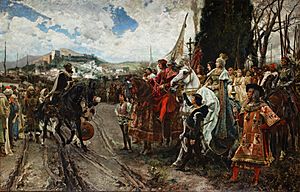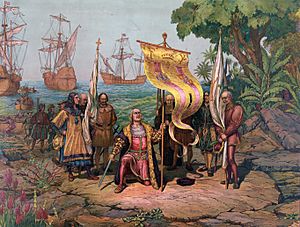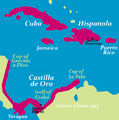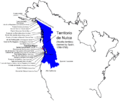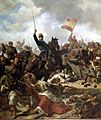Spanish Empire facts for kids
Quick facts for kids
Spanish Empire
Imperio Español
|
|||||||||
|---|---|---|---|---|---|---|---|---|---|
| 1492–1976 | |||||||||
|
Cross of Burgundy Flag
|
|||||||||
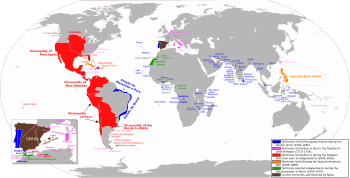 |
|||||||||
| Capital | Toledo (1492-1561) Madrid (since 1561) | ||||||||
| Common languages | Spanish | ||||||||
| Religion | Roman Catholic | ||||||||
| Government | Monarchy | ||||||||
| Monarch | |||||||||
|
• 1516-1556
|
Charles I | ||||||||
|
• 1886-1902
|
Maria Christina of Austria, Regent during the minority of king Alphonse XIII | ||||||||
| House of Habsburg | |||||||||
| House of Bourbon | |||||||||
| History | |||||||||
| 1492 | |||||||||
|
• Conquest of the Aztec Empire
|
1519-1521 | ||||||||
|
• Conquest of the Inca Empire
|
1532–1537 | ||||||||
|
• Loss of the Spanish Sahara
|
1976 | ||||||||
| Currency | Spanish real, Spanish escudo | ||||||||
|
|||||||||
The Spanish Empire was one of the biggest empires in history. It was also one of the first truly global empires. This means it had lands and influence all over the world.
After a long period called the Reconquista, Spain became a very powerful country. It led the way in exploring new parts of the world. Spain built large areas called Viceroyalties in the Americas. These were like big regions ruled by a viceroy, who was a representative of the Spanish king.
Spain also created the first trade routes that crossed entire oceans. Spanish ships carried goods across the Atlantic Ocean. They traded between Spain and its lands in the Americas. They also traded across the Pacific Ocean, connecting Asian-Pacific countries with Mexico. This was done using special ships called treasure fleets and Manila galleons.
Spanish Conquistadores were explorers and soldiers. They conquered the Aztec, Inca, and Maya Empires. They often had help from other Native American tribes. Spain took control of huge areas in North, South America, Asia, Africa, and Oceania. These lands became part of the Spanish Empire.
The kingdom of Castile in Spain grew very powerful. Spanish monarchs also made alliances with other European countries through royal marriages. This helped Spain gain control of many territories in Europe. With lands and colonies all over the world, the Spanish Empire became very rich and strong.
For a long time, Spain had a very strong Navy. Its soldiers, called Tercios, were famous for being undefeated for about 150 years. Spain also had a special time called a cultural golden age in the 16th and 17th centuries. Famous writers like Cervantes, who wrote Don Quixote, and others like Lope de Vega and Calderón de la Barca lived during this time. They made great contributions to literature, art, and thinking.
However, other countries like France, Portugal, and Britain started to challenge Spain. In the second half of the 17th century, Spain faced financial problems. Its military also began to lose battles. In the 19th century, Spain lost most of its remaining lands overseas. This happened after the Spanish-American War.
Contents
The Spanish Empire: A Global Power
The Spanish Empire was truly global, with lands spread across the world. Because of its vast size, it often fought with other powerful countries. These fights were about land, trade, or religion.
Here are some of the conflicts the Spanish Empire was involved in:
- In the Mediterranean, Spain fought the Ottoman Empire. The Ottomans were a threat to Europe and supported pirates.
- Spain fought against France over control of rich Italian states.
- Spain was involved in the American Revolutionary War.
- Spain also fought against Protestant groups in Germany.
- The Dutch Republic fought Spain in the Eighty Years' War.
- Spain and England had many conflicts over centuries. England became a Protestant nation under Henry VIII. His daughter, Elizabeth I, continued to persecute Catholics. England also helped the Dutch rebels. These conflicts led to the famous Spanish Armada. The British also tried to take rich Spanish lands in the Americas. They succeeded in taking Jamaica and, for a time, Spanish Florida.
Many of these powerful countries fought at the same time for long periods. They fought over political and religious differences, and because they wanted more power.
How the Empire Changed in Europe
Over time, the Spanish Empire slowly lost power in Europe. It gradually lost land to other empires. In 1648, Spain and many other countries signed the Peace of Westphalia. This treaty ended both the Thirty Years' War and the Eighty Years' War. In 1659, the Treaty of the Pyrenees ended fighting between France and Spain. These treaties marked the beginning of Spain losing its top position in Europe.
In 1713, Felipe V signed the Peace of Utrecht. In this treaty, Spain gave up its lands in Italy and The Netherlands. Spain was no longer the strongest power in Europe. However, it still played an important role in European politics. It also kept a very large empire in the Americas and the Pacific.
Growth and Challenges Overseas
Even as it lost power in Europe, Spain kept its large overseas empire. It even managed to make it bigger in some areas. The Spanish Empire fought against Britain, France, and the United Provinces. These countries were all trying to gain more land in the New World. Spain remained a major economic power. However, it eventually lost its colonies in the Americas. This happened through civil wars and revolutions in those regions.
When the Empire Ended
Spain held onto two colonies in the Americas: Cuba and Puerto Rico. It also kept the Philippines and some islands in Oceania. These included the Caroline Islands (like the Palau Islands) and the Marianas (including Guam). However, after Spain lost the Spanish-American War in 1898, it lost almost all of these last territories. Spain only kept control of a few small islands in Oceania (not including Guam). Spain sold these islands to Germany in 1899.
Spain still had territories in Africa. It controlled Morocco, Western Sahara, and Equatorial Guinea. These lands gained their independence in the 1960s and 1970s. The last colony to become independent was the Western Sahara in 1975.
What Was the Spanish Empire?
The Spanish Empire usually refers to Spain's lands overseas. These were in the Americas, Africa, the Pacific, and even parts of Europe. For example, lands like the Low Countries or Spanish Netherlands were considered part of the empire. They were owned by the King of Spain, ruled by Spanish officials, and defended by Spanish soldiers.
Some historians use "Habsburg" and "Spanish" when talking about the empire of Charles V or Philip II. This is because the Habsburg family ruled Spain during that time. The Low Countries were effectively part of Spain during this period.
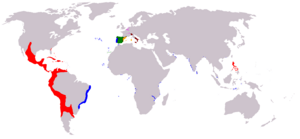
The Portuguese colonial empire also joined Spain for a time. It was ruled by the same monarch in a "personal union". However, Portugal remained a separate state. The Portuguese empire continued to be ruled from Lisbon. So, for a while, there was a joint Spanish-Portuguese rule. These combined empires are sometimes called the Spanish-Portuguese Empire.
The marriage of Ferdinand II of Aragon and Isabella I of Castile in 1469 was very important. It created a union of Aragon and Castile. This union of the Catholic Monarchs helped Spain become a modern state.
In 1492, Spain finished a 781-year period called the Reconquista. This ended with the fall of the last Moorish kingdom of Granada. In that same year, the Catholic Monarchs paid for Christopher Columbus's voyage. He wanted to reach India by sailing west. Instead, Columbus found America. This was the start of the Spanish colonization of the continent.
In 1494, the Treaty of Tordesillas divided the world into two halves between Spain and Portugal. Spain had the right to start colonies in all of the New World. This included lands from Alaska to Cape Horn (except Brazil). Spain also had rights to parts of Asia. The Castilian Empire grew quickly. It expanded into the New World, the Philippines, and colonies in Africa. For example, Melilla was captured in 1497 and Oran in 1509.
Lasting Impact of the Spanish Empire
The Spanish Empire had a huge and lasting impact on the world. The Spanish language and the Roman Catholic Church were brought to the Americas and the Spanish East Indies. This colonization began in the 15th century.
Along with the Portuguese empire, the Spanish empire helped create global trade and culture. They opened up major trade routes across the oceans. The Spanish Dollar became the world's first global currency.
The "Laws of the Indies" were rules that guided life in the Americas for centuries. These laws aimed to protect the native people. This led to a mixing of different groups, like Spaniards, Native Americans, and Black people. You can still see this mix in many countries that were part of the Spanish Monarchy.
The Spanish monarchy did not call its overseas lands "colonies." Instead, they were called Viceroyalties or Overseas Provinces.
The Spanish Empire left a rich cultural, urban, and architectural heritage. Hundreds of towns and cities in the Americas were founded during Spanish rule. You can still see many old universities, forts, cathedrals, schools, hospitals, and government buildings today. Many roads, canals, ports, and bridges built by Spanish engineers centuries ago are still in use. The oldest universities in the Americas were started by Spanish scholars and Catholic missionaries.
The Spanish Empire also left a huge cultural and language legacy. Today, Spanish is the second most spoken native language in the world. This is because the language of Castile, "Castellano," was brought from Spain to Spanish America. The Catholic Church is another major cultural legacy. It remains the main religion in Spanish America. Spanish culture also influenced the music, architecture, food, and fashion in many parts of Spanish America.
The Spanish language and the Roman Catholic faith were spread to America, parts of Africa, and the Spanish East Indies. This started with Spanish colonization in the 15th century. Spain also played a key role in keeping the Catholic Church strong in Europe when it faced many challenges.
The long period of Spanish rule in America led to a mixing of different peoples. Most Hispanic people in the Americas have a mix of European and Indigenous ancestors. Some also have African ancestry.
The Spanish Empire, along with the Portuguese Empire, created the first truly global trade networks. They opened up major trade routes across the oceans. The Spanish Dollar became the world's first global currency.
One important part of this trade was the exchange of plants and animals. This is known as the Columbian Exchange. Many plants and animals were brought from the Old World (Europe, Asia, Africa) to the New World (Americas). These included wheat, barley, apples, cattle, sheep, pigs, horses, and donkeys. The New World gave the Old World things like maize (corn), potatoes, chili peppers, tomatoes, tobacco, beans, squash, cacao (chocolate), vanilla, avocados, pineapples, and peanuts. This exchange greatly improved farming in America, Europe, and Asia.
Related pages
Images for kids
-
Crowns and Kingdoms of the Catholic Monarchs in Europe (1500)
-
El gran capitán at the Battle of Cerignola.
-
The conquest of the Canary Islands (1402–1496)
-
Monument to Columbus, Statue commemorating New World discoveries. Western façade of monument. Isabella at the center, Columbus on the left, a cross on her right. Plaza de Colón, Madrid (1881–85)
-
Iberian-born pope Alexander VI promulgated bulls that invested the Spanish monarchs with ecclesiastical power in the newly found lands overseas.
-
Approximate reconstruction of the route of Juan Ponce de León on his voyage of discovery of Florida (1513)
-
Puerto Plata, Dominican Republic. Founded in 1502, the city is the oldest continuously inhabited European settlement in the New World.
-
Cumaná, Venezuela. Founded in 1510, the city is the oldest continuously inhabited European city in the continental Americas.
-
Battle of Vega Real (1494)
-
Spanish territories in the New World around 1515
-
Cerro de Potosí, discovered in 1545, the rich, sole source of silver from Peru, worked by compulsory indigenous labor called mit'a
-
Spanish galleon, the mainstay of transatlantic and transpacific shipping, engraving by Albert Durer
-
Philip V of Spain (r. 1700–1746), the first Spanish monarch of the House of Bourbon.
-
Representation of the two powers, church and state, symbolized by the altar and the throne, with the presence of the king Charles III and the Pope Clement XIV, seconded by the Viceroy, Antonio Bucareli, and the Archbishop of Mexico, Alonso Núñez de Haro, respectively, before the Virgin Mary. "Glorification of the Immaculate Conception".
-
San Felipe de Barajas Fortress Cartagena de Indias. In 1741, the Spanish repulsed a British attack on this fortress in present-day Colombia in the Battle of Cartagena de Indias.
-
Portrait of Alexander von Humboldt by Friedrich Georg Weitsch, 1806
-
Spanish expedition to Oran (1732)
-
Battle of Cartagena de Indias (1741). Spain managed to defeat Britain and inflict heavy casualties.
-
Painting of Bernardo de Gálvez at the Siege of Pensacola (1781) during the American War of Independence. Gálvez cleared the south part of the United States of the British fortresses
-
Spanish territorial claims on the West Coast of North America in the 18th century, contested by the Russians and the British. Most of what Spain claimed in Nootka was not directly occupied or controlled.
-
Spanish Constitution of 1812 enacted by the Cortes of Cádiz
-
The explosion of the USS Maine in Havana Harbor led to U.S. intervention in the Cuban War of Independence
-
A map of Equatorial Guinea
-
General Prim at the Battle of Tétouan
-
A photo of Cathedral of Mexico City, it is one of the largest cathedrals in Americas, built on the ruins of the Aztec main square.
-
The clock of Comaygua Cathedral's bell tower in Honduras is one of the oldest clocks in Americas and the oldest still working in the world. It was brought from the Alhambra Arab palace to the Spanish colonies during the 17th century.
-
Villa de Leyva, Colombia plaza de armas. Spain impregnate its public square style in present-day Hispanic America.
-
Templo del Carmen in San Luis Potosí City, Mexico in January 2014, it is one of the largest churches in Americas.
-
Roof tiles are a common Hispanic American architectural element because Spanish colonization. Hospital Escuela Eva Perón in Granadero Baigorria, Santa Fe, Argentina.
-
Detail of a Mural by Diego Rivera at the National Palace of Mexico showing the ethnic differences between Agustín de Iturbide, a criollo, and the multiracial Mexican court
See also
 In Spanish: Imperio español para niños
In Spanish: Imperio español para niños



